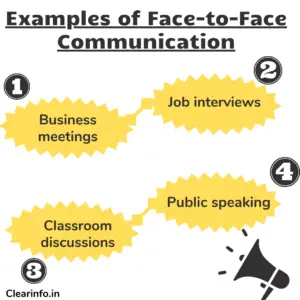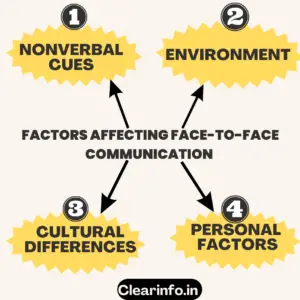Face-to-face communication has been the cornerstone for exchanging information or ideas between people who are physically present in the same location. In this blog, we will explore both the advantages and disadvantages of face-to-face communication in more detail.
What is face-to-face communication?
Face-to-face communication involves direct interaction between two or more individuals who are typically present in the same physical location and is considered a form of interpersonal communication.
It involves verbal and nonverbal exchanges of information, including words, facial expressions, tone of voice, gestures, and body language.
Face-to-face communication allows individuals to connect more deeply, build trust, and develop a greater understanding of one another’s thoughts, feelings, and perspectives.
It is considered the most effective form of communication as it allows for immediate feedback and the opportunity to clarify any misunderstandings.
Face-to-face communication can take place in various settings, such as in the workplace, at home, or in social situations, and is essential for building and maintaining strong relationships.
10 advantages and disadvantages of face-to-face communication?
Advantages of face-to-face communication
1) Clarity of message: One of the foremost benefits of Face-to-face communication is that it allows for greater clarity of message as individuals can observe each other’s nonverbal cues and adjust their message accordingly.
2) Building trust: In-person communication allows individuals to establish trust through eye contact, body language, and tone of voice. This can be particularly important in professional or personal relationships.
3) Instant feedback: Face-to-face communication allows for instant feedback, as individuals can respond in real-time to questions or concerns, which can help to resolve issues quickly.
This is because face-to-face communication provides the opportunity to adjust messages in real time based on the receiver’s reactions and responses.
4) Establishing connectivity: In-person communication is ideal for establishing connectivity and building relationships with others. People can pick up on small changes in facial expressions, body language, and tone of voice, which can help them understand how someone is feeling and respond appropriately.
This can help to establish a sense of empathy and connection, which can be challenging to achieve through written or digital communication.
5) Personal touch: Face-to-face communication allows for a personal touch that is often missing from digital communication, which can help to build stronger connections between individuals.
6) Nonverbal communication: Face-to-face communication allows for the use of nonverbal communication such as facial expressions, gestures, and body language, which can help to convey a more complex message.
Must Read: What are the advantages and disadvantages of nonverbal communication
7) Flexibility: Greater flexibility in terms of the content of the conversation is another crucial merit of in-person communication along with the ability to change course if necessary. This flexibility is particularly useful in situations where the conversation is complex, sensitive, or emotionally charged.
8) Ability to gauge interest: Face-to-face communication allows individuals to gauge the interest and engagement of the other party, which can be difficult to determine through digital communication.
9) Ability to resolve conflict: Effective face-to-face communication can be useful for resolving conflicts as it allows for a more honest and open dialogue. which can help to address and resolve conflicts more effectively.
When people are communicating in person, they can pick up on nonverbal cues such as body language, tone of voice, and facial expressions, which can give them a more complete understanding of the other person’s perspective.
This can help to build empathy and understanding, which can be critical for resolving conflicts.
10) Better retention: Studies have shown that face-to-face communication is more effective for the retention of information than digital communication, as it allows individuals to better focus and engage in the conversation.
Disadvantages of face-to-face communication:
1) Time-consuming: The major drawback of In-person communication is that it can be time-consuming, particularly if the individuals involved are located far apart.
When people are located far apart, they may need to travel a long distance in order to meet in person, which can take a considerable amount of time.
2) Limited reach: Face-to-face communication is limited by geography and can be difficult to maintain with individuals who are located in different parts of the world.
This can limit the frequency and duration of face-to-face interactions. Therefore makes it more challenging to build and maintain personal relationships, especially in professional settings.
3) Limited documentation: In-person communication does not provide a permanent record of the conversation. This means that it can be difficult to refer back to the conversation later, particularly if there were important details or decisions discussed.
4) Limited accessibility: Face-to-face communication can be difficult for individuals with disabilities, particularly those with hearing or vision impairments. Therefore in these conditions, visual communication can be more beneficial to communicate effectively.
5) Cost: In-person communication can be expensive, particularly if it involves travel or accommodations. This is because meeting in person often requires individuals to incur expenses.
For businesses, in-person communication can be particularly expensive, as it may require sending employees to different locations for meetings or conferences.
6) Distractions: A significant disadvantage of face-to-face communication is distractions. When people communicate in person, they are often subject to interruptions from other people, external noise, or environmental factors that can interfere with the quality and effectiveness of communication.
7) Limited time: In-person communication is often limited by the amount of time that the individuals involved have available to meet. This can be particularly problematic when individuals have busy schedules or conflicting priorities, making it challenging to find a mutually convenient time and place to meet
8) Limited privacy: In-person communication may not provide the same level of privacy as digital communication, particularly if the individuals are meeting in a public space.
9) Limited flexibility: In-person communication can be difficult to reschedule or adjust if unforeseen circumstances arise. This is because in-person communication often requires a physical presence and a set time and place, which can be difficult to change at short notice.
For example, if two individuals plan to meet in person to discuss an important business matter, and one of them falls ill or has a family emergency, it can be challenging to reschedule the meeting.
10) Language barriers: Face-to-face communication can be difficult if the individuals involved do not speak the same language, requiring the use of a translator or interpreter.
Face-to-face communication examples?
Here are some examples of face-to-face communication:

- Business meetings: Face-to-face communication is an important part of many business meetings. This allows colleagues to discuss important issues, brainstorm ideas, and make decisions together.
- Job interviews: In-person interviews are still a common way for employers to assess job candidates. Face-to-face communication during the interview process allows employers to evaluate a candidate’s communication skills, personality, and other important qualities.
- Classroom discussions: Face-to-face communication is also important in educational settings. Classroom discussions allow students to ask questions, share ideas, and learn from each other.
- Public speaking: When giving a speech or presentation, the speaker is communicating face-to-face with the audience. This allows them to engage with the audience, read their body language, and adjust their message as needed.
These are just a few examples of face-to-face communication. In general, face-to-face communication allows people to connect on a more personal level and can be more effective than other forms of communication in certain situations.
Benefits and limitations of face-to-face over virtual communication
Both virtual and direct communication have their benefits and limitations, and choosing the appropriate communication method depends on the situation, the message being communicated, and the preferences of the individuals involved.
Benefits of In-person Communication over virtual communication:
#1 Nonverbal Communication: Face-to-face allows for the observation and interpretation of nonverbal cues, such as facial expressions and body language, which can provide additional context and meaning to the conversation. Virtual communication may not always convey nonverbal cues effectively.
#2 Personal Connection: In-person communication can help build personal connections and trust between individuals, as they can interact on a more personal level and engage in activities like shared meals or experiences. Virtual communication may not always facilitate the same level of personal connection.
Limitations of In-person Communication over virtual communication:
#1 Limited Reach: Direct communication is limited to a specific geographic location, making it difficult to communicate with individuals who are not physically present. Virtual communication can reach individuals in different geographic locations.
#2 Time and Cost: In-person communication requires travel and can be time-consuming and expensive, particularly for individuals or organizations with a distributed workforce.
Pros and cons of face-to-face communication in business
Businesses must carefully consider the costs and benefits of face-to-face communication in determining whether it is the most appropriate communication method for a given situation.
Pros of face-to-face communication in business:
- Builds Trust: Formal communication channels such as face-to-face communication helps build trust and credibility between employees. When people meet in person, they are more likely to form personal connections and relationships, which can help strengthen business partnerships and collaborations.
- Better Understanding: Face-to-face communication allows teams to exchange information, ideas, and feedback in real-time. This can help ensure that all parties have a clear understanding of each other’s perspectives, goals, and expectations.
Cons of face-to-face communication in business:
- Time and Cost: Face-to-face communication can be time-consuming and costly, particularly for businesses with a geographically dispersed workforce. Travel expenses, lodging, and meal costs can add up quickly, which can be a significant burden for smaller businesses.
- Limited Reach: Face-to-face communication is limited to a specific geographic location, making it difficult to communicate with professionals who are not physically present. This can be a disadvantage for businesses that have employees, partners, or customers located in different regions or countries.
What are the merits of face-to-face communication over written communication?
Face-to-face communication offers several advantages over written communication:
- Flexibility: Face-to-face communication offers greater flexibility in terms of message delivery and content. Individuals can adjust their message in real time based on the response and feedback of the person they are communicating with. With written communication, the message is fixed, and there is less room for flexibility and adaptation.
- Less Ambiguity: Face-to-face communication can help reduce ambiguity and increase clarity in the message being conveyed, as individuals can ask questions and seek clarification in real time. With written communication, there is often more ambiguity, and the message may be interpreted differently by different people.
Related Reading: Check out our detailed article where we have discussed the advantages and disadvantages of written communication
Comparison between Online communication vs face-to-face communication
Criteria | Online Communication | Face-to-Face Communication |
Nonverbal cues | Limited or absent | Present and observable |
Real-time feedback | Delayed, limited, or absent | Immediate and more effective |
Personal connection | Limited, and can be difficult to establish or maintain | Strong, and can be established or maintained more easily |
Flexibility | High, with multiple options for communication methods | Low, with fewer options for communication methods |
Technology dependence | High, requires technology and internet connectivity | Low, not dependent on technology or internet connectivity |
Limitations of digital communication
- Limited personal connection: Digital communication can feel impersonal and may not allow for the same level of personal connection as face-to-face communication. This can be a drawback in situations where building relationships is important.
- Technical difficulties: Digital communication relies on technology, which can be unreliable and prone to technical difficulties such as poor connection quality, and software glitches. These issues can disrupt communication and cause frustration or delays.
- Inability to read social context: Digital communication often lacks the context of the situation or social environment in which the message is being conveyed. This can make it difficult to understand the intended meaning or tone of a message.
Must Read: 15 Advantages & Disadvantages of Digital Communication With Examples
Four factors that affects face-to-face communication

1. Nonverbal cues: Nonverbal cues, such as facial expressions, tone of voice, and body language, can heavily influence how a message is received and interpreted.
2. Environment: The environment in which face-to-face communication takes place, such as the lighting, noise level, and seating arrangement, can impact how comfortable and effective the communication is.
3. Cultural differences: Cultural differences can impact how messages are conveyed and received, as well as how individuals interpret and respond to nonverbal cues.
4. Personal factors: Personal factors, such as personality, and past experiences, can impact how individuals communicate and respond to communication. For example, If an individual is experiencing stress or anxiety, they may face challenges in communicating effectively and may also misunderstand messages communicated to them by others
Must Read: 12 key factors that can influence the effectiveness of communication
How to overcome the fear of face-to-face communication
Here are five tips on how to overcome the fear of face-to-face communication:
1) Practice: The more you practice, the more comfortable you will become with face-to-face communication. Start with simple conversations and slowly work your way up to more challenging ones.
2) Prepare: Before important conversations or presentations, take the time to prepare what you want to say. This can help you feel more confident and less anxious.
3) Focus on the listener: Instead of focusing on your own anxiety, focus on the listener and what they need from you. This can help shift your attention away from your fear and onto the task at hand.
4) Take deep breaths: When you start to feel anxious, take deep breaths and try to relax your body. This can help calm your nerves and improve your ability to communicate effectively.
5) Seek support: Don’t be afraid to ask for help or support from a friend, colleague, or professional. They have the ability to provide advice and constructive criticism to assist you in enhancing your communication abilities and conquering your apprehension.
Frequently Asked Questions
Q1: What are the advantages of face-to-face communication?
A: Face-to-face communication has several advantages, including the ability to convey emotion and nonverbal cues, build personal connections and trust, and provide immediate feedback and clarification.
Q2: What are the disadvantages of face-to-face conversation?
A: Face-to-face conversation also has some drawbacks, such as the potential for misinterpretation due to cultural or language differences, the risk of conflict or uncomfortable situations, and the limitation of time and space.
Q3: What are the 3 advantages of face-to-face learning?
A: Three advantages of face-to-face learning are the ability to ask questions and receive immediate feedback, the opportunity to engage in group discussions and collaborative activities, and the potential for personalized instruction and mentorship.
Q4: What are the disadvantages of talking in person?
A: Disadvantages of talking in person can include potential distractions and interruptions, difficulty in finding a convenient time and location for the conversation, and the need to adjust to different communication styles and preferences.



